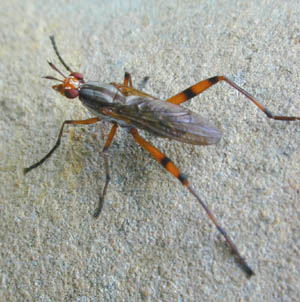
The Acalyptratae or Acalyptrata are a subsection of the Schizophora, which are a section of the order Diptera, the "true flies". In various contexts the Acalyptratae also are referred to informally as the acalyptrate muscoids, or acalyptrates, as opposed to the Calyptratae. All forms of the name refer to the lack of calypters in the members of this subsection of flies. An alternative name, Acalypterae is current, though in minority usage. It was first used by Justin Pierre Marie Macquart in 1835 for a section of his tribe Muscides; he used it to refer to all acalyptrates plus scathophagids and phorids, but excluding Conopidae.
Leander (Franz) Czerny was an Austrian entomologist mainly interested in Diptera.

The Lauxanioidea are a superfamily of flies that includes the two large families, the Lauxaniidae and Chamaemyiidae, and the small family Celyphidae. Generally, they are small to medium, densely populated, coloured flies. The Chamaemyiidae and Cremifaniidae live as parasites on insects. The family Celyphidae look like beetles.

| Chamaemyia is a genus of flies in the family Chamaemyiidae. It is the type genus of its family.

Chamaemyia elegans is a species of fly in the family Chamaemyiidae. It is present in Europe, including mainland France.
Chamaemyia flavipalpis is a species of fly in the family Chamaemyiidae. It is found in the Palearctic.
The Cremifaniidae are a very small family of acalyptrate flies with only 4 described species worldwide. All species are considired rare, and nothing is known of their life history. They were formally placed in the family Chamaemyiidae.
Pseudodinia antennalis is a species of fly in the family Chamaemyiidae.
Pseudodinia is a genus of flies in the family Chamaemyiidae. There are about 17 described species in Pseudodinia.
Pseudodinia polita is a species of fly in the family Chamaemyiidae.
Chamaemyia nigripalpis is a species of fly in the family Chamaemyiidae. It is found in the Palearctic.
Chamaemyia paludosa is a species of fly in the family Chamaemyiidae. It is found in the Palearctic.
Chamaemyia sylvatica is a species of fly in the family Chamaemyiidae. It is found in the Palearctic.
Chamaemyia triorbiseta is a species of fly in the family Chamaemyiidae. It is found in Scotland.
Parochthiphila argentiseta is a species of fly in the family Chamaemyiidae. It is present in Turkey.
Chamaemyia flavoantennata is a species of fly in the family Chamaemyiidae. It is found in the Palearctic.
Chamaemyia submontana is a species of fly in the family Chamaemyiidae. It is found in the Palearctic.
Chamaemyia hungarica is a species of fly in the family Chamaemyiidae. It is only found in Hungary.



